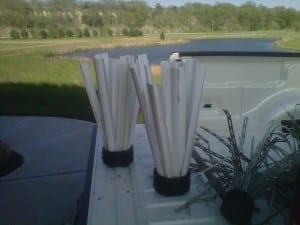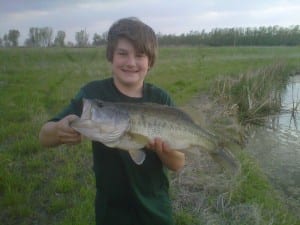Published Saturday May 21st, 2011
A7
R. Allen Curry
Commentary
The fishing season is upon us and when the spring flood recedes this season, New Brunswick’s brook trout will face a new onslaught of apparently starving anglers.
Fishermen cast for trout on Lac Baker. The provincial government’s decision to double the catch limit for brook trout in northwestern New Brunswick has raised questions about whether cabinet is playing politics with conservation.
The Minister of Natural Resources, backed by the premier, has increased the number of trout that can be harvested by an angler each day from five to 10 in the streams and rivers of northwestern N.B. According to the minister, he has good data for the trout populations and he is 100-per-cent confident the data demonstrates that doubling the harvest is sustainable. He stated that not all his biologists agree his decision is in the best interest of the trout populations. In addition, his local MLAs asked their constituents if they believed this would be a good decision and some of them thought it was a good idea.
It appears the minister is unsure of the sustainability of the increased harvest, because he is also quoted as promising more stocking of hatchery raised trout to help sustain these populations if they become depleted by harvesting.
Every new government has new ideas and approaches to managing our society’s assets, things like our health care, education, economy, and our environment. This particular tale of 10 trout shows our newest government in action and sends a clear message about Premier Alward’s approach to managing our assets.
Five trout, or 10?
The tale begins with a decision based on the proclaimed accurate data. How many fish can we harvest is a question asked by all fisheries managers, and indeed provincial staff are working hard and doing what they can, with very limited people and finances, to set harvest levels across the province. I have published a few scientific papers on N.B.’s brook trout populations, completed some population estimates on these northern and other populations, and have visited many brook trout streams here and across their range, so I asked to see the data the minister used to make his decision.
It won’t surprise you to know that with the continuing reductions in DNR staffing and their operational finances for fish and wildlife monitoring, the actual data is quite limited. It has many gaps, it is highly variable, and the methods for data collection are inconsistent. That doesn’t mean tables and diagrams for reports and presentations can’t be generated, but the results are impossible to interpret and therefore the data are unreliable.
There is data not discussed by the minister, which is staff surveys of how many anglers are out there and how many trout they are taking (angler effort and harvest rates). The existing data have the same quality control issues mentioned, but they tell a consistent story the biologists all agree is real.
In the northwest, anglers on average harvest seven trout per day, and elsewhere the harvest is less than three trout per day. In other words, that region’s trout populations are already under more harvesting pressure than populations elsewhere in N.B.
The statements made by anglers when they are surveyed and documented in reports bear this out: “I will catch 10, bring them back to the camp and then go back to get more.” Critical to decision making, but missing in reports and the minister’s comments, are analyses to show how many trout in total will now be harvested, how that will be monitored, and if increasing the harvest by 100 per cent (five to 10 trout) is sustainable, especially given the known pressure on these populations.
The minister indicated that more stocking of trout in the northwestern streams could occur next year to “help sustain the trout population(s).” If you read the minister’s policy for stocking fish it states, “DNR’s fish management strategies focus on responsible management of fish habitat and fish populations to promote natural reproduction of wild fish populations.”
The policy goes on to state, “it is important that the department consider all other management options prior to stocking.” The easiest option is controlling the harvest by anglers. And, implicit in the policy is that stocking streams is not a preferred option unless the stream supports a sea-run population of trout, which don’t occur upstream of the Mactaquac Dam near Fredericton.
If the northwestern brook trout populations can sustain a 100-per-cent increase in harvesting, why would DNR have to stock non-wild, hatchery trout and additionally, take this action against their policy?
The minister has stated that not all of his biologists agree with an increased trout harvest. He didn’t tell us if that was the majority opinion.
The last of the minister’s statements, and one that the Premier and other ministers are using for other issues, is their consultation with MLAs and their constituents. For the people they talked with, the “reaction was overwhelmingly positive” in favour of increasing the trout harvest.
I’m certain the majority of NBers would overwhelmingly support a reduction in taxes, but that doesn’t make it a wise choice for a sustainable province.
I know many people not in favour of increasing the trout harvest, but they may not have been the loudest voices heard by the minister and Premier. Consultation is an important element for any government initiative, but selective questioning or listening is not the best method to consult, report and act.
Act with caution
I’m obviously concerned about the brook trout, because I have no confidence that we understand the consequences of increasing the harvest in this region. If we can’t predict the outcome, then most of us would recommend erring on the side caution until we learned more to improve our likelihood of making the correct decision.
Take, for example, another fish issue, the cod fishery of eastern Canada. Scientists and many fishers stated their concern about continuing to increase harvests, and the decision makers chose to go against this advice. The result was the collapse of those populations and the fisheries they supported, which became both an ecological and economic disaster.
That doesn’t have to be the case in this situation. If the minister wants to change the harvest, an investment in accurate assessments and monitoring for a few years would produce the actual information needed to make a decision that sustains our fish populations and the fisheries they support.
Will the world end if brook trout populations in northwestern N.B. are lost? The answer is no, but by depleting these populations we increase the stress on their ecosystems and degrade the fishing quality and opportunities that were, after all, the original intent of the minister’s actions.
One final item that is disconcerting in this tale of 10 trout is the consistent, low priority placed on the environment by the current governing political party. In addition to the brook trout, this government (even if it didn’t start the process) has decreased the protected forest areas for deer and protecting water, undermined their protection of wetlands, allowed shale gas exploration despite unequivocal concerns for contaminating groundwater, and permitted direct pollution of waterways to allow mining opportunities to proceed. All of these actions are against the spirit of our provincial laws that protect the environment, but this government and prior governments repeatedly invoke discretionary, opt-out-of-the-law clauses provided to ministers. It would be interesting to know how many times this occurs, who benefits, and why.
In fairness to the politicians we elect, it is their job to make decisions regarding how society will operate. In fairness to the people who elect them, politicians should be completely transparent about how they made their decisions.
If a decision to increase brook trout harvests in northwestern N.B. is made because the cabinet believes the majority of voters want it to happen, then just say that despite the best advice of your staff and the majority of experts, your decision is political.
If you make a decision to develop and lose a wetland or pollute one of our waterways, just tell us publicly the reason why. Your honesty would allow people to debate and provide governments with informed opinions about how to manage our society. Indeed, it would be the best solution if the cabinet (and all cabinets) would tell us what political and dollar value it is placing on the loss of a wetland, a stream ecosystem, or a trout population. That knowledge and honesty would go a long way in educating the people whom you represent and garnering their support for your decisions.
Everything I have read and heard about Premier Alward leads me to believe he is an honest person with a desire to bring honesty and transparency to his role as leader of our province.
So far, Premier Alward’s government has yet to demonstrate a willingness to be honest and transparent about his decisions regarding our environment.
R. Allen Curry, Ph.D. is a Professor of Recreational Fisheries and Director of the Canadian Rivers Institute at UNB.
 DRIFTLESS FARM (PHOTO BY UW-STEVENS POINT)
DRIFTLESS FARM (PHOTO BY UW-STEVENS POINT)  DRIFTLESS AREA (BY NATIONALATLAS.GOV)
DRIFTLESS AREA (BY NATIONALATLAS.GOV) 




.jpg)


